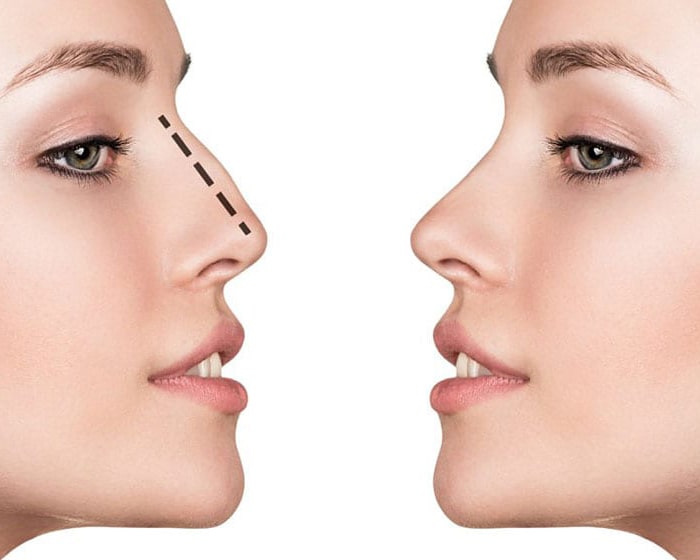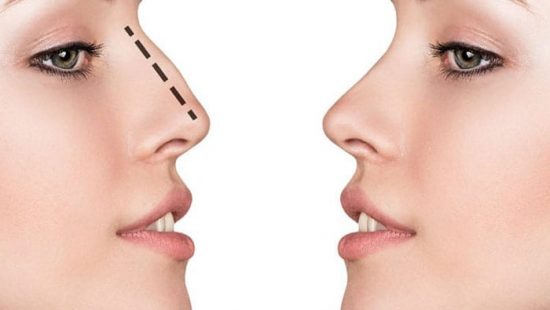Rhinoplasty
Description ( Overview)
An attractive face is all about balance & proportion. The nose, located front and center, provides the foundation for this sense of aesthetic balance. With the help of a skilled, qualified cosmetic surgeon, the nose can be reshaped and refined to enhance a patient’s natural beauty.
Rhinoplasty, or nose reshaping surgery, improves the shape, size, and symmetry of a person’s nose, bringing it into better proportion with the rest of the face. When performed by a skilled, qualified cosmetic surgeon, rhinoplasty can be a rewarding and life-enhancing procedure—patients often notice that their overall appearance has improved, as the nose they see now looks natural, like the nose they have always thought they should have.
Why rhinoplasty is reguired?
Rhinoplasty, sometimes referred to as a “nose job” or “nose reshaping” by patients, enhances facial harmony and the proportions of your nose. It can also correct impaired breathing caused by structural defects in the nose.
By reshaping the nasal structures, including bone, cartilage, and skin, a cosmetic surgeon can help achieve one or more of the following:
- Straighten a crooked nose
- Smooth a prominent bump in the bridge of the nose
- Reduce the length of an over-protruding nasal tip
- Refine the size of a bulbous nasal tip
- Narrow a nose that is too wide for the face
- Reduce the size of a nose that is too large
- Restore symmetry to the nose following injury
- Correct breathing problems by opening up blocked nasal passages
If you desire a more symmetrical nose, keep in mind that everyone’s face is asymmetric to some degree. Results may not be completely symmetric, although the goal is to create facial balance and correct proportion.Nose surgery that’s done to improve an obstructed airway requires careful evaluation of the nasal structure as it relates to airflow and breathing.Correction of a deviated septum, one of the most common causes of breathing impairment, is achieved by adjusting the nasal structure to produce better alignment.
Why Iran Is Suitable For Rhinoplasty?

Patient Eligibility \ Who Can Have Rhinoplasty ?
Men and women of all ages benefit from rhinoplasty. Nose reshaping is one of the more popular cosmetic surgery procedures for teenage patients too, although cosmetic surgeons take special care when evaluating whether or not a younger patient is ready for rhinoplasty. Physically, the nose must be fully developed—typically by around age 14 for girls and 16 for boys. Younger patients also need to demonstrate emotional maturity and understanding about the cosmetic surgery process.
For patients of any age, it is important to have realistic expectations. Rhinoplasty can help you improve upon your existing nose, but it cannot deliver “perfection” nor can it give you the nose of someone else. A skilled, qualified cosmetic surgeon will explain to you what is possible and help you achieve a nose that looks natural with your unique features.
How Is Rhinoplasty Done? (Procedures)
Nose surgery is highly individualized, and the exact techniques a cosmetic surgeon will use during a procedure will look a little different each time, depending on a patient’s anatomy and desired changes. In general, however, a cosmetic surgeon’s techniques will fall under one of the following procedural approaches.
Open rhinoplasty
An incision is made across the columella (the skin of the central strut of the nose separating the two nostrils. The incision is carried up and around the rim of the nostrils, allowing the skin on the nose to be peeled back. The surgeon then has a direct view of the cartilage, which they can then refashion. This technique is used for the very complicated, difficult and injured nose but is also used exclusively by some surgeons.
Closed rhinoplasty
The closed rhinoplasty does not have an incision across the skin of the columella between the nostrils, but is carried out through the mucosa of the inside of the nose. The surgeon does not have the direct view of the nasal skeleton and therefore it is a technique for the more experienced surgeon.
Septo-Rhinoplasty
A septo-rhinoplasty is commonly done to improve the way you breathe through your nose. This is often done for patients who suffer from a deviated septum. The septum is the cartilage and bone inside your nose that divides the nostrils.
Your surgeon will make an incision in the mucosa (the lining inside your nose), and lift it off the bone and cartilage in order to remove any parts that are bent, putting them into a straight position allowing for clear breathing. This procedure will improve the way you breathe, and the appearance of your nose can be adjusted as well.
Rhino-tip Surgery
Rhino-tip surgery is done to change the shape of the nose by modifying the structure of the underlying cartilage. Most alterations are done from inside the nose so as to minimize any scarring. Your surgeon can create the perfect tip for your nose structure.
Some common cases that patients come in for are:
– Big Tip: This is a rounded appearance at the tip of the nose, possibly due to thick skin.
– Crooked Tip: One nostril may appear larger than the other or the nose might be slanted to one side causing an asymmetrical look.
– Flared Nostrils: When the nostrils are larger and spread farther apart creating an upturned of flat-nose appearance.
– Hooked Tip: This is when the nose juts out and is overly-long, particularly noticeable on the profile of the patient.
The Oriental and African Nose Augmentation
Many patients have noses which are flatter with wider nostrils. In these cases, it is not a question of reducing the skeletal support, but adding to it. The bridge line can be raised by adding a manmade substance or the patient’s own bone and cartilage taken from the ear, skull or rib. In each case, the extra tissue is carved to the required shape. Nostrils and nostril floor can be reduced in width by removing a wedge of tissue. The oriental may on occasions need surgery of the upper eyelid, and particularly the inner end where there is often web.
Preparation & recovery
How should I prepare for rhinoplasty?
In preparing for rhinoplasty surgery, you may be asked to:
- Get a lab test
- Take certain medications or adjust your current medications
- Stop smoking
- Avoid taking aspirin, anti-inflammatory drugs and herbal supplements as they can increase bleeding
Your plastic surgeon will also discuss where your procedure will be performed.
Rhinoplasty may be performed in an accredited office-based surgical facility, a licensed ambulatory surgical center or a hospital.
Rhinoplasty is typically performed as an outpatient procedure using general anesthesia, although local anesthesia with intravenous sedation may be appropriate in certain cases. After your procedure, your nose may be placed in a splint. This helps to support your newly reshaped nose and protect it from accidental contact. You may also go home with packing inside your nostrils—this can be uncomfortable, but temporary. Packing is typically removed within the first week after rhinoplasty. Your cosmetic surgeon will prescribe pain medication to help minimize discomfort during your initial recovery.
Take it easy after rhinoplasty
For the first 1 to 2 weeks, many patients experience bruising and swelling. At first, you may not be able to see the improvements made during surgery. But don’t worry—the majority of bruising and swelling should subside after the first 10 to 14 days. Most patients feel ready to return to work or school after 1 or 2 weeks, depending on the level of activity required. Typically after 3 weeks, most normal non-contact activities can be resumed. However, limit activity according to your surgeon’s instructions and do not engage in any strenuous activities until you are cleared to do so.
Your new nose will continue to improve
While you will be able to see the improvements your cosmetic surgeon made during rhinoplasty after the initial bruising and swelling dissipates, it is normal to have some slight residual swelling present for up to a year. This is usually not noticeable to others, though.
The results of rhinoplasty surgery are permanent. While this means your new nose will be with you for a lifetime, it also makes it that much more important to choose a qualified cosmetic surgeon whom you can trust to deliver the results you desire.
If you’re considering rhinoplasty, the best way to learn about your options is to meet with a board certified cosmetic surgeon for a consultation.
Other options
In certain cases, the nose can be reshaped non-surgically with dermal fillers, providing improvements that last up to a year. By strategically injecting a filler at certain points in the nose, a skilled cosmetic surgeon can help smooth out bumps, reshape the nasal tip, and improve nasal symmetry. Although the results are temporary, this non-surgical approach can be a cost-effective way for patients to “test-drive” a nose reshaping procedure before committing to the permanent changes possible with surgical rhinoplasty.
Risks & Complication
What are the risks of rhinoplasty?
The decision to have plastic surgery is extremely personal. You will have to decide if the benefits will achieve your goals and if the risks and potential complications of rhinoplasty are acceptable.
Rhinoplasty surgery risks include:
- Anesthesia risks
- Infection
- Poor wound healing or scarring
- Change in skin sensation (numbness or pain)
- Nasal septal perforation (a hole in the nasal septum) is rare. Additional surgical treatment may be necessary to repair the septum but it may be impossible to correct this complication
- Difficulty breathing
- Unsatisfactory nasal appearance
- Skin discoloration and swelling
- Possibility of revisional surgery
These risks and others will be fully discussed prior to your consent. It is important that you address all your questions directly with your plastic surgeon.

